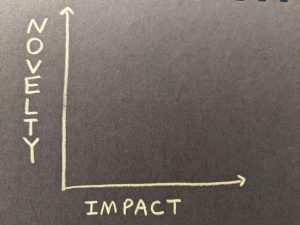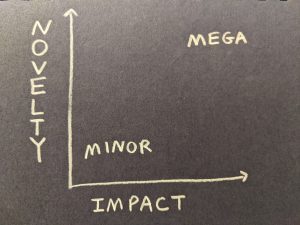
Here at ITK, we define innovation as “novelty with impact.” Just last week, it occurred to me to turn that definition into a graph, with Novelty along one axis and Impact along the other (seriously, how did I not think of this sooner?). At the low end of the Novelty axis, we find things that are Kinda Familiar, while at the high end things are Utterly Unique. Similarly, things at the low end of the Impact axis are Kinda Helpful, while the high end is full of products and services that SAVE THE WORLD.
So, the lower left quadrant might be minor innovations, things that are both kinda familiar and kinda helpful. The upper right quadrant is mega innovations. Both quadrants are innovative, just to different degrees. So far, so good, right?
 OK, the really interesting thing isn’t in either of those quadrants. Instead, it’s this arrow that points down and to the right. I call it the Innovation Maturity Slope, and it shows what happens when an innovative product or service becomes… popular (so maybe we should call it the popularity slope?).
OK, the really interesting thing isn’t in either of those quadrants. Instead, it’s this arrow that points down and to the right. I call it the Innovation Maturity Slope, and it shows what happens when an innovative product or service becomes… popular (so maybe we should call it the popularity slope?).
 Here’s what’s happening along this slope: popularity leads to familiarity, which reduces novelty. People see the thing and respond “Oh yeah, I’ve heard of that.” But popularity also means more people benefit from the thing, which means impact increases.
Here’s what’s happening along this slope: popularity leads to familiarity, which reduces novelty. People see the thing and respond “Oh yeah, I’ve heard of that.” But popularity also means more people benefit from the thing, which means impact increases.
The net result: popularity moves us down and to the right.
Think of what happens to an iPod, a cool new app, or the latest software development method. At first, a small number of early adopters use the thing, so it is relatively uncommon (high-N) and its impact is constrained to a relatively small group (low-I). It sits in the upper left quadrant. But later, everyone gets an iPod, discovers the app, or adopts Agile software methods. As more people use the thing and benefit from it, it becomes less novel but more impactful.
The reason I’m sharing this is to point out: this change can feel like a loss to the person behind the innovation. It might even feel like a failure, as if they “aren’t innovative anymore,” because their creation is less novel than it was before. It’s super easy to mistake a drop in novelty for a lack of innovation, even when impact is increasing. But the thing to remember is that novelty is not the point. For that matter, innovation isn’t the point either. Impact is the point – doing something that matters, solving a problem, creating value, helping people, making things better.
So if you are fortunate enough to see your project move to the right along the Impact axis, remember to count that as a sign of maturity and progress. It’s definitely a win.
